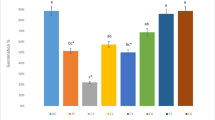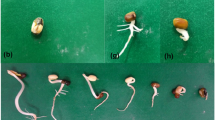Abstract
Mature maize (Zea mays) embryos were exposed to 5, 10 and 25 µg ml−1 of deoxynivalenol (DON), zearalenone (ZEA), ochratoxin A (OA) and a mixture of zearalenone and deoxynivalenol (ZEA/DON) for 9 days. DON and the ZEA/DON combination were consistently more inhibitory of the measured parameters than either ZEA or OA. Based on the predicted additive values, it would appear that, in combination, ZEA and DON act synergistically to inhibit root and shoot growth. For ZEA alone, a concentration of 5 µg ml−1 ZEA was generally inhibitory of root and shoot elongation and fresh mass accumulation, while at 10 and 25 µg ml−1, this toxin had a stimulatory effect on these parameters. For OA, the measured effects on root and shoot growth at 5 and 25 µg ml−1 were stimulatory, while at 10 µg ml−1 OA, an inhibitory effect was observed. For all toxins, inhibitory/stimulatory effects were generally more marked for root parameters than for shoot elongation or mass.
Similar content being viewed by others
Abbreviations
- ADON:
-
acetyldeoxynivalenol
- AFB1 :
-
aflatoxin B1
- DAS:
-
diacetyoxyscirpenol
- DON:
-
deoxynivalenol
- FB1 :
-
fumonisin B1
- FHB:
-
Fusaium head blight
- MON:
-
moniliformin
- NIV:
-
nivalenol
- OA:
-
ochratoxin A
- ZEA:
-
zearalenone
References
Christensen CM, Kaufmann HH. Microflora. In: Christensen CM (ed), Storage of Cereal Grains and their Products, St. Paul: American Association of Cereal Chemists, 1974: 158–92.
Christensen CM, Sauer DB. Microflora. In: Christensen CM (ed), Storage of Cereal Grains and Their Products. St Paul: American Association of Cereal Chemists, 1982: 219–40.
Mycock DJ, Berjak P. Paradoxical behaviour of seed-storage and field fungi: an overview. S Afr J Sci 1992; 88: 371–75.
McLean M, Berjak P. Maize grains and their associated mycoflora — a micro-ecological consideration. Seed Sci & Technol 1987; 15: 831–50.
Hsieh DPH. Mode of action of mycotoxins. In: Hsieh DPH (ed), Mycotoxins in Food. Cambridge: Academic Press, 1987: 149–76.
Wang YZ, Miller JD. Effect ofFusarium graminearum metabolites on wheat tissue in relation to fusarium head blight resistance. J Phytopathol 1988; 122: 118–25.
Atanassov Z, Nakamura C, Mori N, Kaneda C, Kato H, Jin Y-Z, Yoshizawa T, Murai K. Mycotoxin production and pathogenicity ofFusarium species and wheat resistance to Fusarium head light. Can J Bot 1994; 72: 161–67.
Yoder OC. Toxins in pathogenesis. Annu Rev Phytopathol 1980; 18: 103–29.
Mańke M, Chelkowski J, Brayford D, Visconti A, Kwaśna K, Perkowski J.Fusarium graminearum Schwabe (TeleomorphGibberella zeae Schw. Petch) — Cultural characteristics, pathogenicity towards cereal seedlings and ability to produce mycotoxins. J Phytopathol 1989; 124: 143–48.
Snijders CHA, Perkowski J. Effects of head blight caused byFusarium culmorum on toxin content and weight of wheat kernels. Phytopathology 1990; 80: 566–70.
Beremand MN, Desjardins AE, Hohn TM, VanMiddlesworth FL. Survey ofFusarium sambucinum (Gibberella pulicaris) for mating type, trichothecene production, and other selected traits. Phytopathology 1991; 81: 1452–58.
Snijders CHA, Krechting CF. Inhibition of deoxynivalenol translocation and fungal colonization in Fusarium head blight resistant wheat. Can J Bot 1992; 70: 1570–76.
Snijders CHA. Breeding for resistance toFusarium in wheat and maize. In: Miller JD, Trenholm HL, (eds), Mycotoxins in Grain. Compounds other than Aflatoxin. St. Paul: Eagan Press, 1994; 37–58.
Wakuliński W. Phytotoxicity ofFusarium metabolites in relation to pathogenicity. In: Chelkowski J (ed),Fusarium Mycotoxins, Taxonomy and Pathogenicity. Amsterdam: Elsevier Press, 1989; 257–68.
Adams GC, Hart LP. The role of deoxynivalenol and 15-acetyldeoxynivalenol in pathogenesis byGibberella zeae, as elucidated through protoplast fusions between toxigenic and non-toxigenic strains. Phytopathology 1989; 79: 404–408.
Desjardins AE, Hohn TM, McCormick SP. Trichothecene biosynthesis inFusarium species: Chemistry, genetics, and significance. Microbiol Rev 1993; 57: 595–604.
Reinert J, Yeoman MM. Plant Cell and Tissue Culture. Berlin: Springer-Verlag, 1982.
Bruins MBM, Karsaï I, Schepers J, Snijders CHA. Phytotoxicity of deoxynivalenol to wheat tissue with regard to in vitro selection for Fusarium head blight resistance. Plant Sci 1993; 94: 195–206.
Mirocha CJ, Weiping X, Yichun X, Wilcoxson RD, Woodward RP, Etebarin RH, Behele G. Production of trichothecene mycotoxins byFusarium graminearum andFusarium culmorum on barley and wheat. Mycopathologia 1994; 128: 19–23.
Wakulińki W. Phytotoxicity of the secondary metabolites of fungi causing wheat head fusariosis (head blight). Acta Physiol Plant 1989; 11: 301–306.
Shimada T, Otani M. Effects ofFusarium mycotoxins on the growth of shoots and roots at germination in some Japanese wheat cultivars. Cereal Res Commun 1990; 18: 229–32.
Bottalico A, Leario P, Visconti A. Some experimental data on the phytotoxicity of mycotoxins. Phytopath Medit 1980; 19: 196–98.
Bandurska H, Chelkowski J, Wiśniewska H. Free proline accumulation in wheat seedlings influenced byFusarium culmorum infection and the pathogen metabolite deoxynivalenol. Acta Physiol Plant 1994; 16: 111–16.
Menke-Milczarek I, Zimny J. Phytotoxicity of deoxynivalenol to wheat calli. Mycotox Res 1991; 7: 146–49.
Packa D. Cytogenetic changes in plant cells as influenced by mycotoxins. Mycotox Res 1991; 7: 150–55.
Rahman MF, Bilgrami KS, Masood A. Cytotoxic effects of DON and T-2 toxin on plant cells. Mycopathologia 1993; 124: 95–97.
Betina V. Structure-activity relationships among mycotoxins. Chem-Biol Interact 1989; 71: 105–46.
McLaughlin CS, Vaughan MH, Campbell IM, Wei CM, Stafford ME, Hansen BS. Inhibition of protein synthesis by trichothecenes. In: Rodricks JV, Hesseltine CW, Mehlman MA (eds), Mycotoxins in Human and Animal Health. Park Forest South: Pathotox Publishers, 1977; Vol. 1: 63–73.
Jarvis BB, Midiwo JO, Tuthill D, Bean GA. Interaction between the antibiotic trichothecenes and the higher-plantBaccharis megapotamica. Science 1981; 214: 460–62.
Schoental R. Mycotoxins and the toxicity of plants. Chemistry in Britain 1984; 1108, 1113.
Mánke M, Visconti A, Chelkowski J, Bottalico A. Pathogenicity ofFusarium isolates from wheat, rye, and triticale towards seedlings and their ability to produce trichothecenes and zearalenone. Phytopathol Z 1985; 113: 24–29.
Hagler W, Tycskowska K Hamilton PB. Simultaneous occurrence of deoxynivalenol, zearalenone, and aflatoxin in 1982 scabby wheat from the midwestern United States. Appl Environ Microbiol 1984; 47: 151–54.
Miller JD. Effects ofFusarium graminearum metabolites on wheat cells. In: Graniti A, Durbin RD, Ballio A (eds), Phytotoxins and Plant Pathogenesis. NATO ASI Ser. H. Cell Biol. 1989; 27: 449–52.
Wolf JC, Lieberman JR, Mirocha CJ. Inhibition of F-2 (zear-laenone) biosynthesis and perithecium production inFusarium roseum ‘Graminearum’. Phytopathology 1972; 62: 937–39.
Powell-Jones W, Raeford S, Lucier GW. Binding properties of zearalenone mycotoxins to hepatic estrogen receptors. Mol Pharmacol 1981; 20: 35–42.
Martin PM, Horowitz KB, Ryans DS, McGuire WL. Phytoestrogen interaction with estrogen receptors in human breast cancer cells. Endocrinology 1978; 103: 1860–67.
Mirocha CJ, Pathre SV, Robison TS. Comparative metabolism of zearalenone and transmission into bovine milk. Cosmet Food Toxicol 1981; 19: 25–30.
Kuiper-Goodman T, Scott PM. Risk assessment of the mycotoxin ochratoxin A. Biomed Environ Sci 1989; 2: 179–248.
Zill G, Engelhardt G, Wohner B, Wallnofer PR. The fate of Fusarium mycotoxin zearalenone in maize cell suspension cultures. Mycotox Res 1990; 6: 31–40.
Scheel D, Sandermann H. Metabolism of 2,4-dichlorphenoxyacetic acid in cell cultures of soybean (Glycine max L.) and wheat (Triticum aestivum L.). Planta 1981; 152: 253–58.
Krogh P, Hald B, Pederson EJ. Occurrence of ochratoxin A and citrinin in cereals associated with mycotoxin porcine nephropathy. Acta Path Microbiol Scand Sect B 1973; 81: 689–95.
Abramson D, Sinha RN, Mills JT. Mycotoxin formation in moist 2-row and 6-row barley during granary storage. Mycopathologia 1987; 97: 179–95.
Rotter RG, Marquard RR, Frohlich AA, Abramson D. Ensiling as a means of reducing ochratoxin A concentrations in contaminated barley. J Sci Food Agr 1990; 50: 155–66.
Stømer FC, Støren O, Hansen CE, Pedersen JI, Aasen AJ. Formation of (4R)- and (4S)-4- hydroxyochratoxin A and 10-hydroxyochratoxin A from ochratoxin A by rabbit liver microsomes. Appl Environ Microbiol 1983; 45: 1183–87.
Ruhland M, Engelhardt G, Wallnöfer PR. Transformation of the mycotoxin ochratoxin A in wheat and maize cell suspension cultures. Naturwissenschaften 1994; 81: 453–54.
Creppy EE, Størmer FC, Röschenthaler R, Dirheimer G. Effects of two metabolites of ochratoxin A, (4R)-4-hydroxyochratoxin A and ochratoxin α, on immune response in mice. Infect Immun 1983; 39: 1015–18.
Rahimtula AD, Béréziat J-C; Bussacchini-Griot V, Bartsch H. Lipid peroxidation as a possible cause of ochratoxin A toxicity. Biochem Pharmacol 1988; 37: 4469–77.
McLean M, Berjak P, Watt MP and Dutton MF. The influence of aflatoxin B1 on thein vitro germination and growth of excised, matureZea mays embryos. J Nat Toxins 1993; 2: 13–26.
McLean M. Towards an understanding of the effects of aflatoxin B1 on plant tissue. PhD Thesis, University of Natal, South Africa, 1993.
van Asch MAJ. Studies on the resistance of wheat and maize to fungal pathogenesis. PhD Thesis, University of Natal, Pietermaritzburg, South Africa, 1990.
Leath KT, Rowell JB. Thickening of corn mesophyll walls in response to invasion by Puccinia graminis. Phytopathology 1969; 59: 1654–56.
Wheeler H. Cell wall and plasma membrane modifications in diseased and injured plant tissues. Can J Bot 1974; 52: 1005–1009.
Author information
Authors and Affiliations
Corresponding author
Rights and permissions
About this article
Cite this article
McLean, M. The phytotoxicity of selected mycotoxins on mature, germinatingZea mays embryos. Mycopathologia 132, 173–183 (1995). https://doi.org/10.1007/BF01103984
Received:
Accepted:
Issue Date:
DOI: https://doi.org/10.1007/BF01103984




